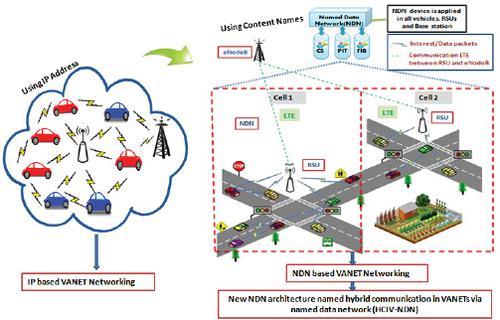当前位置:
X-MOL 学术
›
Int. J. Commun. Syst.
›
论文详情
Our official English website, www.x-mol.net, welcomes your feedback! (Note: you will need to create a separate account there.)
Hybrid communication architecture in VANETs via named data network
International Journal of Communication Systems ( IF 2.1 ) Pub Date : 2021-05-08 , DOI: 10.1002/dac.4848 Khadija Raissi 1 , Bechir Ben Gouissem 1
International Journal of Communication Systems ( IF 2.1 ) Pub Date : 2021-05-08 , DOI: 10.1002/dac.4848 Khadija Raissi 1 , Bechir Ben Gouissem 1
Affiliation

|
The limitations of the transmission control protocol/Internet protocol (TCP/IP) model have given birth to a new futuristic trend called named data networking (NDN), focusing on retrieving the desired data by using content names instead of host addresses. In this context, we proposed another NDN architecture named hybrid communication in vehicular ad hoc networks (VANETs) via named data network (HCIV-NDN) to reduce packet loss, eliminate the unnecessary message exchange, and to assume that in one cluster not all receivers nodes rebroadcast. Also, it investigates the NDN concept to vehicle to road side unit (V2R), vehicle-to-vehicle (V2V), and road side unit to infrastructure (R2I) plus vehicle-to-infrastructure (V2I) communications to enlarge the connectivity of vehicles. The vehicles are clustered and can communicate with the base station, with road side unit (RSU), and among them to define a new data dissemination protocol. Hence, the HCIV-NDN mechanism applies two types of timers to select some farthest nodes as forwarder to rebroadcast packets at different times. Thus, we study the performance of our HCIV-NDN with node density effects for smart cities and then we compare it with the existing location-based deferred broadcast (LBDB) scheme. Simulation results exhibited that HCIV-NDN scheme achieves more than 90% in terms of the cache-hit ratio when the percent of consumers interested in the same data is about 50%. Then it performs better than LBDB in terms of satisfaction ratio, packet loss ratio, and the average delay in a suburban scenario.
中文翻译:

VANETs中通过命名数据网络的混合通信架构
传输控制协议/互联网协议 (TCP/IP) 模型的局限性催生了一种称为命名数据网络 (NDN) 的新未来趋势,专注于通过使用内容名称而不是主机地址来检索所需的数据。在这种情况下,我们通过命名数据网络 (HCIV-NDN) 在车载自组织网络 (VANET) 中提出了另一种称为混合通信的 NDN 架构,以减少数据包丢失,消除不必要的消息交换,并假设在一个集群中并非所有接收器节点重播。此外,它还研究了车对路侧单元 (V2R)、车对车 (V2V) 和路侧单元对基础设施 (R2I) 以及车对基础设施 (V2I) 通信的 NDN 概念,以扩大连接车辆。车辆集群,可以与基站通信,与路侧单元(RSU),并在其中定义新的数据传播协议。因此,HCIV-NDN 机制应用两种类型的定时器来选择一些最远的节点作为转发器,在不同的时间重新广播数据包。因此,我们研究了具有节点密度效应的 HCIV-NDN 对智慧城市的性能,然后将其与现有的基于位置的延迟广播 (LBDB) 方案进行了比较。仿真结果表明,当对相同数据感兴趣的消费者百分比约为 50% 时,HCIV-NDN 方案在缓存命中率方面达到了 90% 以上。那么它在郊区场景下的满意度、丢包率和平均延迟方面的表现都优于LBDB。HCIV-NDN 机制采用两种类型的定时器来选择一些最远的节点作为转发器,在不同的时间重新广播数据包。因此,我们研究了具有节点密度效应的 HCIV-NDN 对智慧城市的性能,然后将其与现有的基于位置的延迟广播 (LBDB) 方案进行了比较。仿真结果表明,当对相同数据感兴趣的消费者百分比约为 50% 时,HCIV-NDN 方案在缓存命中率方面达到了 90% 以上。那么它在郊区场景下的满意度、丢包率和平均延迟方面的表现都优于LBDB。HCIV-NDN 机制采用两种类型的定时器来选择一些最远的节点作为转发器,在不同的时间重新广播数据包。因此,我们研究了具有节点密度效应的 HCIV-NDN 对智慧城市的性能,然后将其与现有的基于位置的延迟广播 (LBDB) 方案进行了比较。仿真结果表明,当对相同数据感兴趣的消费者百分比约为 50% 时,HCIV-NDN 方案在缓存命中率方面达到了 90% 以上。那么它在郊区场景下的满意度、丢包率和平均延迟方面的表现都优于LBDB。我们研究了具有节点密度效应的 HCIV-NDN 对智慧城市的性能,然后将其与现有的基于位置的延迟广播 (LBDB) 方案进行了比较。仿真结果表明,当对相同数据感兴趣的消费者百分比约为 50% 时,HCIV-NDN 方案在缓存命中率方面达到了 90% 以上。那么它在郊区场景下的满意度、丢包率和平均延迟方面的表现都优于LBDB。我们研究了具有节点密度效应的 HCIV-NDN 对智慧城市的性能,然后将其与现有的基于位置的延迟广播 (LBDB) 方案进行了比较。仿真结果表明,当对相同数据感兴趣的消费者百分比约为 50% 时,HCIV-NDN 方案在缓存命中率方面达到了 90% 以上。那么它在郊区场景下的满意度、丢包率和平均延迟方面的表现都优于LBDB。
更新日期:2021-06-21
中文翻译:

VANETs中通过命名数据网络的混合通信架构
传输控制协议/互联网协议 (TCP/IP) 模型的局限性催生了一种称为命名数据网络 (NDN) 的新未来趋势,专注于通过使用内容名称而不是主机地址来检索所需的数据。在这种情况下,我们通过命名数据网络 (HCIV-NDN) 在车载自组织网络 (VANET) 中提出了另一种称为混合通信的 NDN 架构,以减少数据包丢失,消除不必要的消息交换,并假设在一个集群中并非所有接收器节点重播。此外,它还研究了车对路侧单元 (V2R)、车对车 (V2V) 和路侧单元对基础设施 (R2I) 以及车对基础设施 (V2I) 通信的 NDN 概念,以扩大连接车辆。车辆集群,可以与基站通信,与路侧单元(RSU),并在其中定义新的数据传播协议。因此,HCIV-NDN 机制应用两种类型的定时器来选择一些最远的节点作为转发器,在不同的时间重新广播数据包。因此,我们研究了具有节点密度效应的 HCIV-NDN 对智慧城市的性能,然后将其与现有的基于位置的延迟广播 (LBDB) 方案进行了比较。仿真结果表明,当对相同数据感兴趣的消费者百分比约为 50% 时,HCIV-NDN 方案在缓存命中率方面达到了 90% 以上。那么它在郊区场景下的满意度、丢包率和平均延迟方面的表现都优于LBDB。HCIV-NDN 机制采用两种类型的定时器来选择一些最远的节点作为转发器,在不同的时间重新广播数据包。因此,我们研究了具有节点密度效应的 HCIV-NDN 对智慧城市的性能,然后将其与现有的基于位置的延迟广播 (LBDB) 方案进行了比较。仿真结果表明,当对相同数据感兴趣的消费者百分比约为 50% 时,HCIV-NDN 方案在缓存命中率方面达到了 90% 以上。那么它在郊区场景下的满意度、丢包率和平均延迟方面的表现都优于LBDB。HCIV-NDN 机制采用两种类型的定时器来选择一些最远的节点作为转发器,在不同的时间重新广播数据包。因此,我们研究了具有节点密度效应的 HCIV-NDN 对智慧城市的性能,然后将其与现有的基于位置的延迟广播 (LBDB) 方案进行了比较。仿真结果表明,当对相同数据感兴趣的消费者百分比约为 50% 时,HCIV-NDN 方案在缓存命中率方面达到了 90% 以上。那么它在郊区场景下的满意度、丢包率和平均延迟方面的表现都优于LBDB。我们研究了具有节点密度效应的 HCIV-NDN 对智慧城市的性能,然后将其与现有的基于位置的延迟广播 (LBDB) 方案进行了比较。仿真结果表明,当对相同数据感兴趣的消费者百分比约为 50% 时,HCIV-NDN 方案在缓存命中率方面达到了 90% 以上。那么它在郊区场景下的满意度、丢包率和平均延迟方面的表现都优于LBDB。我们研究了具有节点密度效应的 HCIV-NDN 对智慧城市的性能,然后将其与现有的基于位置的延迟广播 (LBDB) 方案进行了比较。仿真结果表明,当对相同数据感兴趣的消费者百分比约为 50% 时,HCIV-NDN 方案在缓存命中率方面达到了 90% 以上。那么它在郊区场景下的满意度、丢包率和平均延迟方面的表现都优于LBDB。



























 京公网安备 11010802027423号
京公网安备 11010802027423号